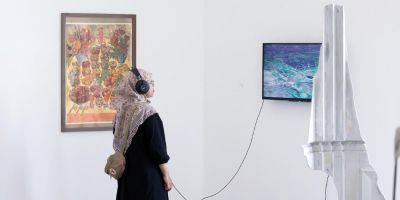Exhibition explores the Language Centre’s role in international politics

For the first time, members of the public can learn about the history of the University of Leeds’ Language Centre in a new temporary exhibition based on materials from its archives.
Today, the Language Centre is known in the university for its English courses, which help students get to grips with academic and subject-specific vocabulary. As any fresher can tell you, it can feel like you have to learn a whole new way of speaking when you start at university: academic English isn’t anyone’s first language.
This exhibition, curated by MA students from the School of Fine Art, History of Art and Cultural Studies, takes a look at how the Language Centre has helped students to learn how to use academic English since it was established 55 years ago.
The Many Forms of English: 55 Years of Language Centre Teaching also explores work that the Language Centre has done with groups from outside the university since 1964. As its archives reveal, the Language Centre has a history of teaching specialised forms of English to diplomats, soldiers and professionals from around the world.
After the fall of the Soviet Union in 1991, the Language Centre formed strong links with Eastern Europe, teaching citizens from all but one former Soviet state. It trained aspiring bankers who had access to the Western financial system for the first time and so needed help with its terminology. After returning home, one participant reported that: “I have been able to put 70% of what I gained into practice and at the same time have been able to pass on a great deal to my colleagues”.
The Language Centre was also employed by the British Council to teach military English to Eastern European armies. This was part of an attempt to make English, not Russian, the primary language used in Eastern Europe after the fall of the Soviet Union, to lessen Russia’s influence in the region. Throughout the 90s, the Language Centre served as a diplomatic tool, showing importance of language.
One of the most touching stories in the Language Centre archives was from 1999. In the aftermath of the Kosovo War, a number of refugees settled in Leeds, but the language barrier was an issue. The Language Centre invited refugee workers to use its resources to learn Albanian and help them feel welcome.
Additionally, two young students from Kosovo enrolled in the University of Leeds, wanting to continue the studies they had started before the war. The Language Centre helped them transition into an English-speaking university, where they pursued degrees in Medicine and Chemistry. Rediscovering this part of the Language Centre’s history whilst creating the exhibition has actually raised questions in the organisation about what the Language Centre can do to help refugees and migrants today.
The Many Forms of English: 55 Years of Language Centre Teaching runs to 21 December and can be found in Room 4.30 in the Parkinson Building, University of Leeds.
The exhibition is one of many installations around the University of Leeds, all of which have been undertaken by MA students from the School of Fine Art, History of Art and Cultural Studies. See here for details of all of this year’s projects.
Image
Language Centre staff, November 2019. Photograph by Simon and Simon Photography.




